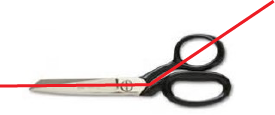Employing the appropriate set of scissors can simplify the execution of your task. If a pair of general cutting scissors are no longer effective, it may be necessary to explore the various types of scissors, trimmers, and shears that are available.
Trimmers
Trimmers come in lengths ranging from 6” to 9”. The blades on this tool are tapered at the end. The bottom blade is rounded to prevent snagging the fabric. Trimmers have handles with two different-sized grip holes that accommodate your four fingers in the bottom and your thumb in the top. There are two different types of trimmers, bent and straight:
 Bent trimmers have a slight angle at the point where the handle meets the blade. When trimming, the angled blade of bent trimmers remains parallel to the surface, thus facilitating the task of keeping the fabric in place between the blades and cutting a straight line.
Bent trimmers have a slight angle at the point where the handle meets the blade. When trimming, the angled blade of bent trimmers remains parallel to the surface, thus facilitating the task of keeping the fabric in place between the blades and cutting a straight line.
 Straight trimmers have blades that are inline with the center of the handle.
Straight trimmers have blades that are inline with the center of the handle.
Pinking Shears
Instead of a straight-edge blade, this tool has a zigzag, saw tooth blade. This tool is useful when cutting a pattern in a non-fray fabric, or in helping to reduce fraying when cutting woven cloth. Most pinking shears have a bent blade and come in lengths of 7-1/2” and 8-1/2”.
Tailor’s Shears
Tailor’s shears have heavier blades than most trimmers and scissors. They are best for cutting more rigid, thick fabrics such as denim and suiting wool. This tool is made with finely tapered blades.
There are two types of scissors used by tailors namely, bent and straight. Similarly, to trimmers, bent scissors have an angled blade and they are specifically made for cutting straight lines in fabrics that are laid flat on a surface. Shears come in 4”, 10”, and 12” lengths. Heavy-Duty Wide Blade Tailor’s Shears are available as well for cutting multiple layers of heavy fabrics.
Embroidery Scissors
These scissors are 4” to 5” long. They are designed for clipping threads and trimming delicate fabrics while embroidering. Embroidery scissors are very sharp and come to a sharp point at the end, making it easy to glide along lightweight fabrics cut with precision. The blades are straight blades inline with the handle. Both sides of the handle are equal size circular shapes.
Sewing Scissors
These 5-6” straight scissors are made for general sewing. The blades on this tool are tapered at the end. One of the blades is slightly rounded at the end to prevent snagging the fabric. Both sides of the handle are equal-sized circular shapes.
Caring for Your Scissors
- Always keep in mind that if you are using fabric cutters, never cut anything other then fabric or you will damage the blade.
- Be sure to wipe your blades clean after every use as fibers from certain fabrics can dull your blade.
- Oil the joint with a small drop of machine oil and wipe the excess off with a soft cloth to keep them cutting smoothly.
- Store your scissors in a protective case.
- Accidentally cutting into a needle may permanently damage your scissors.
- Try to avoid opening and closing your scissors without actually cutting through the fabric.
- Invest in a scissor sharpener.
- It may also be important to know that if you are left-handed or have arthritis, there are special scissors just for you!
Explore More:
- The 10 Best Pinking Shears – Reviews, Buying Guide & FAQs
- The 8 Best Sewing Scissors – Reviews & Buying Guide
- The 5 Best Quilting Scissors – Reviews & Buying Guide
- The 05 Best Mat Cutters – Reviews & Buying Guide
- The 05 Best Knitting Bag – Reviews & Buying Guide
- The 5 Best Sewing Machine Book – Reviews & Guide